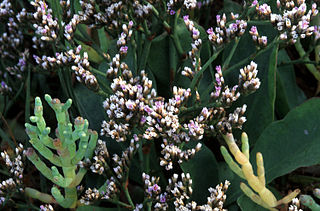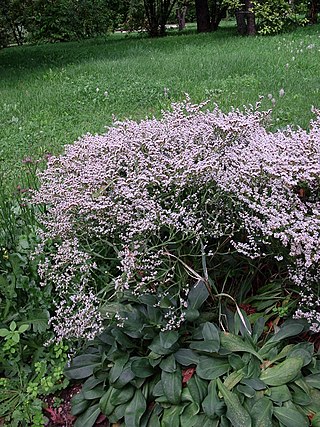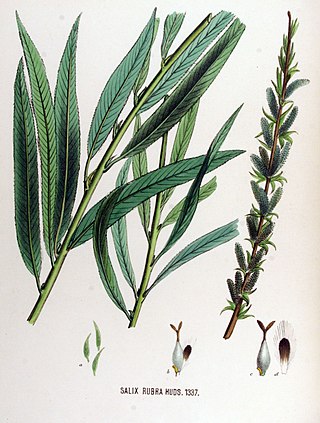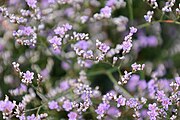
Pelargonium is a genus of flowering plants that includes about 280 species of perennials, succulents, and shrubs, commonly called geraniums, pelargoniums, or storksbills. Geranium is also the botanical name and common name of a separate genus of related plants, also known as cranesbills. Both genera belong to the family Geraniaceae. Carl Linnaeus originally included all the species in one genus, Geranium, and they were later separated into two genera by Charles Louis L'Héritier de Brutelle in 1789.

Limonium is a genus of about 600 flowering plant species. Members are also known as sea-lavender, statice, caspia or marsh-rosemary. Despite their common names, species are not related to the lavenders or to rosemary. They are instead in Plumbaginaceae, the plumbago or leadwort family. The generic name is from the Latin līmōnion, used by Pliny for a wild plant and is ultimately derived from the Ancient Greek leimon.

Lavandula angustifolia, formerly L. officinalis, is a flowering plant in the family Lamiaceae, native to the Mediterranean. Its common names include lavender, true lavender and English lavender ; also garden lavender, common lavender and narrow-leaved lavender.

The elm cultivar Ulmus 'Crispa' [:'curled', the leaf margin], sometimes known as the Fernleaf Elm, arose before 1800 and was first listed by Willdenow as U. crispa (1809). Audibert listed an U. campestrisLinn. 'Crispa', orme à feuilles crépues [:'frizzy-leaved elm'], in 1817, and an Ulmus urticaefolia [:'nettle-leaved elm'] in 1832; the latter is usually taken to be a synonym. Loudon considered the tree a variety of U. montana (1838). In the 19th century, Ulmus × hollandica cultivars, as well as those of Wych Elm, were often grouped under Ulmus montana. Elwes and Henry (1913) listed 'Crispa' as a form of wych elm, but made no mention of the non-wych samara.

Limonium sinuatum, commonly known as wavyleaf sea lavender, statice, sea lavender, notch leaf marsh rosemary, sea pink, is a Mediterranean plant species in the family Plumbaginaceae known for its papery flowers that can be used in dried arrangements.

Limonium arboreum is a species of sea lavender known by the common name tree limonium and siempreviva. It is endemic to the Canary Islands, where it is a plant of coastal habitat.

Limonium californicum is a species of sea lavender in the family Plumbaginaceae. It is known by the common names western marsh rosemary and California sea lavender.

Limonium perezii is a species of Limonium known by the common names Perez's sea lavender and seafoam statice. It is also known as simply statice, sea lavender or marsh rosemary. It is native to the coasts of the Canary Islands but are widely used in gardens throughout the world.

Limonium narbonense is a species of sea lavender belonging to the family Plumbaginaceae.
Statice limonium may refer to:

Goniolimon tataricum is a species of flowering plant in the genus Goniolimon, family Plumbaginaceae. It is called German statice, Tatarian sea-lavender, Tartarian statice or just statice. It is native to Albania, Algeria, Bulgaria, Greece, Kazakhstan, the North Caucasus, Romania, Southern Russia, Tunisia, Ukraine and the former Yugoslavia. It is planted in gardens as a border and ground cover, and also used in the cut flower industry.

Limonium vulgare, called common sea-lavender, is a species of flowering plant in the genus Limonium native to Atlantic parts of Europe from southwestern Sweden to southwestern Iberia and the Azores, and introduced elsewhere. A clumping perennial found in salt marshes and other maritime habitats, it is a probable species complex.

Santolina pinnata, called lavender cotton along with other members of its genus, is a species of flowering plant in the family Asteraceae, native to northwest Italy. Its putative subspecies Santolina pinnata subsp. neapolitana, the rosemary-leaved lavender cotton, has gained the Royal Horticultural Society's Award of Garden Merit.

Salix × rubra, the green-leaved willow or red osier, is a naturally occurring hybrid species of flowering plant in the family Salicaceae. It is the result of crosses between Salix purpurea and Salix viminalis. It is native to a large part of Europe, found where the parent species' ranges overlap. The straight, flexible stems are prized by basketmakers. There are a number of cultivars, with the fastigiate 'Eugenei' being the best known.

Buxus sinica, the Chinese box or small-leaved box, is a species of flowering plant in the family Buxaceae, native to central and southern China, Taiwan, South Korea, and Japan. A shrub or small tree, in the wild it is found in a variety of habitats, usually from 600 to 2,600 m above sea level. There are a number of cultivars, all derived from Buxus sinica var. insularis, including 'Winter Gem', 'Green Gem', 'Justin Brouwers', 'Wintergreen', 'Chegu', 'Tall Boy', 'Tide Hill', 'Winter Beauty', 'Green Mountain', 'Pincushion', 'Filigree', 'Green Velvet', and 'Sunny‑side'. In addition to its use in hedging, it is used in bonsai.

Geranium tuberosum, the tuberous-rooted cranesbill, is a species of flowering plant in the family Geraniaceae. It is native to the Mediterranean region, the Caucasus, and western Asia. The Royal Horticultural Society considers it a good plant to attract pollinators, and it is widely available from commercial suppliers. There are a number of cultivars available, including 'Rosie's Mauve' and 'Richard Hobbs'.

Limonium minutum, the dwarf statice, is a species of flowering plant in the family Plumbaginaceae, native to the Balearic Islands. A halophyte found in coastal habitats, it is occasionally available from commercial suppliers.

Limonium gmelini, the Siberian statice, is a species of flowering plant in the family Plumbaginaceae, native to east-central and southeastern Europe, Russia, the north Caucasus, Turkey, Iran, Kazakhstan, Kyrgyzstan, parts of Siberia, Xinjiang, and Mongolia. A widespread halophytic species, it is found growing in seeps, meadows, steppes, roadsides, and wastelands, as long as they are saline.

Limonium puberulum, the downy sea lavender, is a species of flowering plant in the family Plumbaginaceae, native to Lanzarote in the Canary Islands. It is morphologically similar to but genetically distinct from Limonium bourgeaui.

Limonium bourgeaui is a species of flowering plant in the family Plumbaginaceae, native to Lanzarote and Fuerteventura in the Canary Islands. It is morphologically similar to but genetically distinct from Limonium puberulum.























